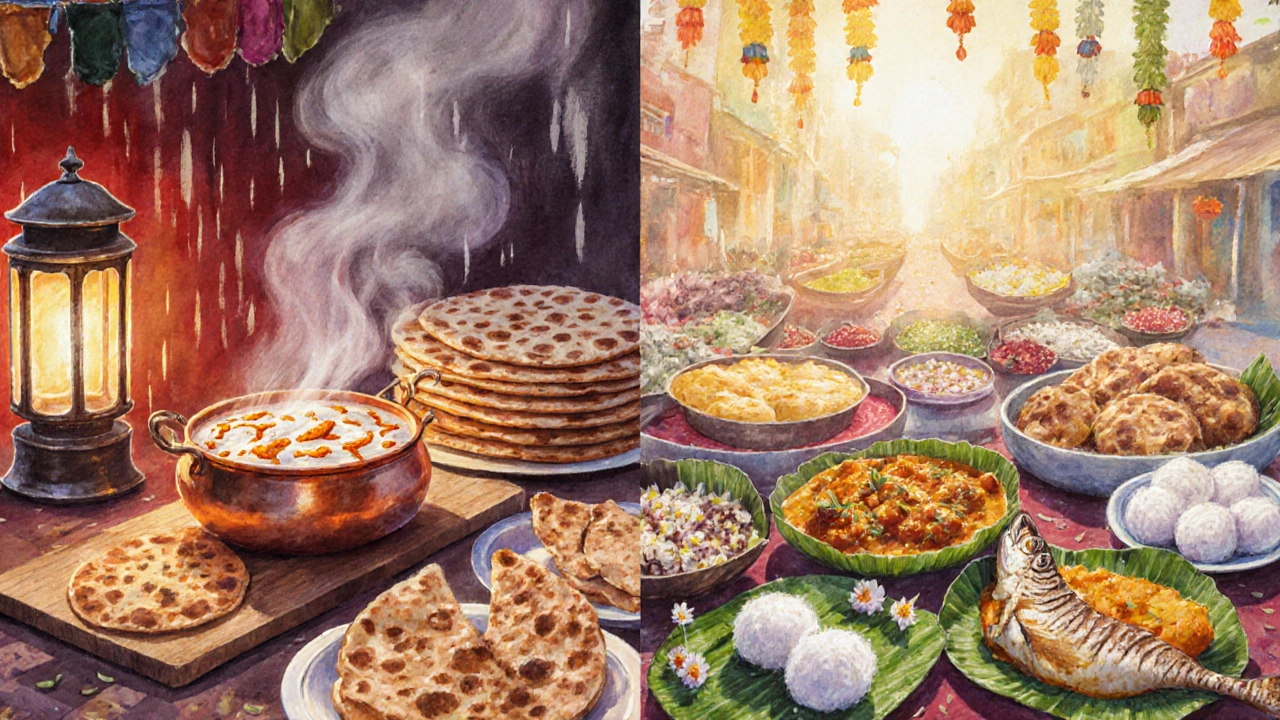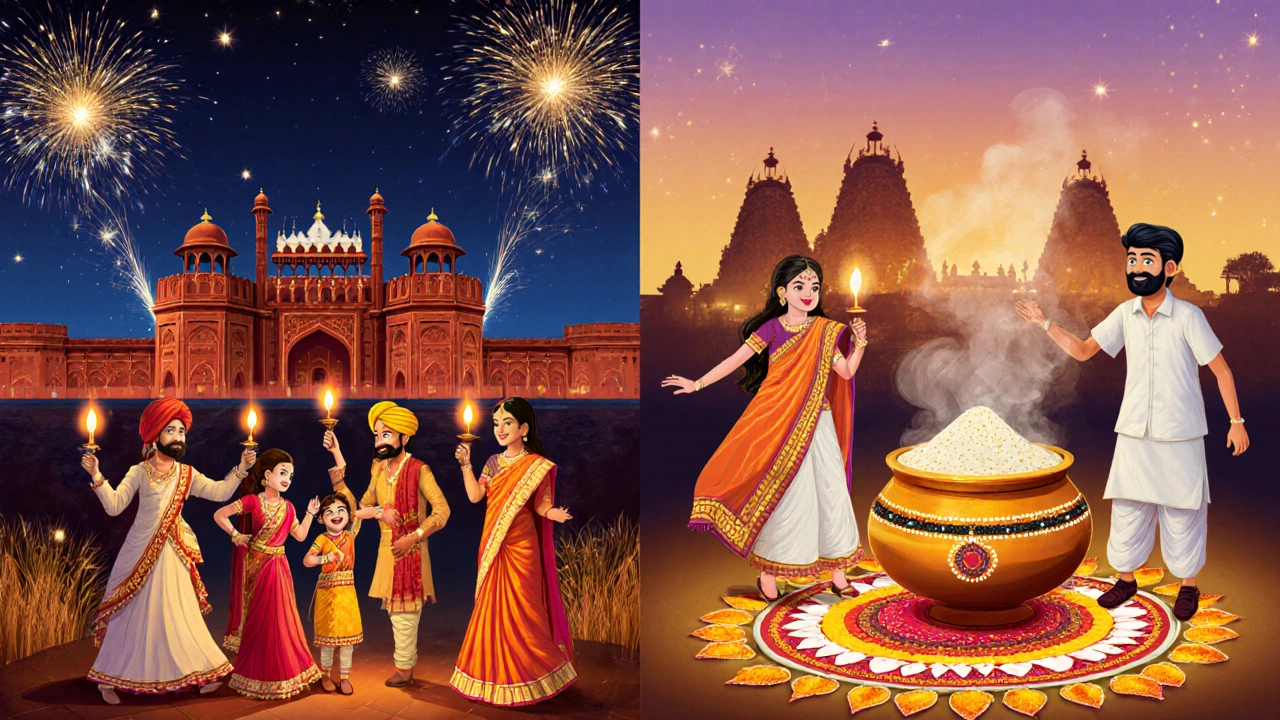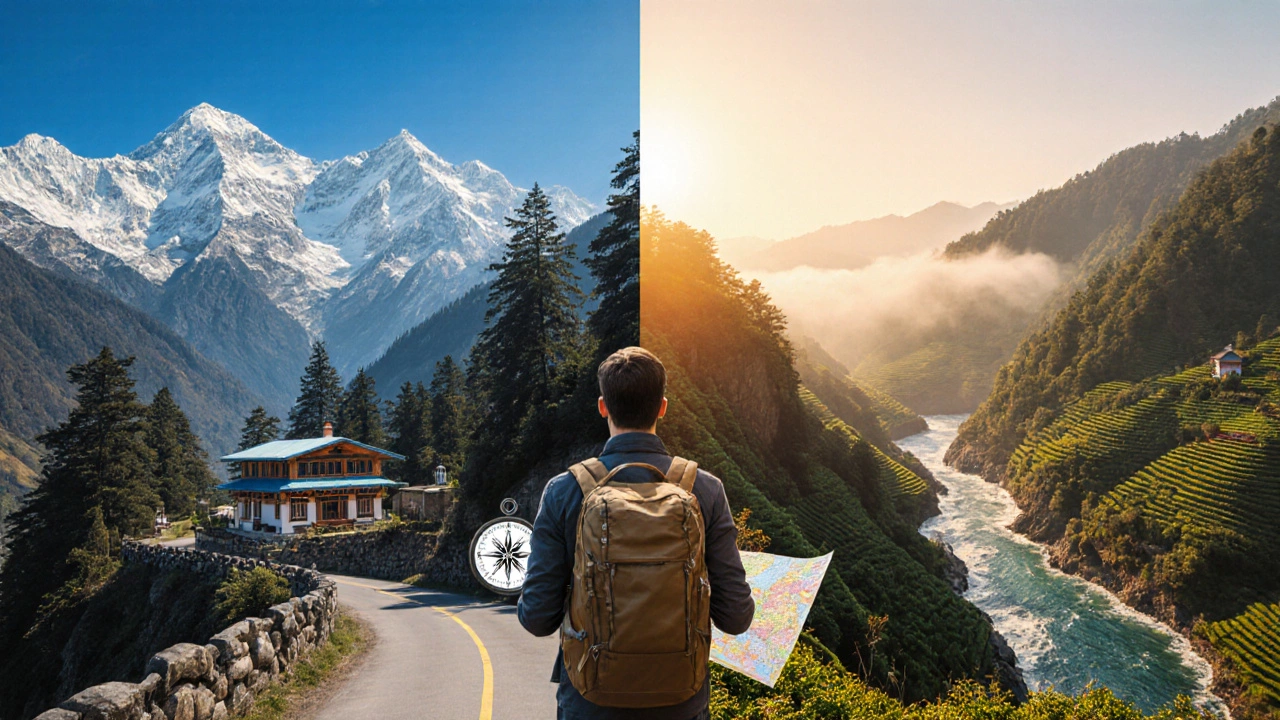Key Takeaways
- Geography, climate and landscapes shape distinct lifestyles in the two regions.
- Languages switch from Indo‑Aryan in the north to Dravidian in the south.
- Food varies from wheat‑based breads and creamy gravies to rice‑centric dishes and tangy tamarind flavors.
- Festivals, dress and architecture reflect the local history and religious traditions.
- Travel tips help you respect local customs and enjoy each region to the fullest.
When you hear "India," it’s easy to picture a single flavor, but the sub‑continent splits into two cultural powerhouses that feel worlds apart. The question North India vs South India often pops up on travel forums, and the answer lies in geography, language, food, festivals, clothing, and even the way people greet you. This guide breaks down those differences so you can plan a trip that captures the full spectrum of Indian life.
Geography and Climate: From the Himalayas to the Western Ghats
First, let’s set the scene with the land itself.
North India is a region that stretches from the mighty Himalayas in the north to the fertile Indo‑Gangetic plains. Its climate swings between scorching summers (up to 45°C) and chilly winters where snow blankets mountain towns such as Shimla and Manali.
South India covers the peninsular tip bounded by the Arabian Sea, Bay of Bengal and Indian Ocean. Here the climate stays warm year‑round, with monsoon rains between June and September that turn the Western Ghats into a lush green corridor.
These geographic extremes shape everything from the crops grown (wheat vs rice) to the types of clothing travelers see on the streets.
Languages: Indo‑Aryan vs Dravidian Roots
India boasts over 1,600 languages, but the north‑south divide narrows the field dramatically.
In the north, Hindi is the most widely spoken Indo‑Aryan language, serving as a lingua franca for states like Uttar Pradesh, Delhi and Rajasthan
While you’ll also hear Punjabi, Gujarati and Kashmiri, Hindi dominates public signage and media.
Travel down to the south and the linguistic landscape flips. Tamil is a classical Dravidian language spoken in TamilNadu; Malayalam dominates Kerala; Kannada is prevalent in Karnataka; and Telugu rules Andhra Pradesh and Telangana.
Even the script changes: Devanagari in the north versus distinct regional scripts like Tamil and Malayalam. A quick tip - learning a few greetings in the local language goes a long way in both regions.
Cuisine: Wheat Bread vs Rice Delicacies
Food lovers, brace yourselves - the culinary gap is huge.
In the north, meals revolve around wheat‑based breads such as roti, naan and paratha. Dishes often feature creamy gravies, dairy, and a handful of spices like cumin, garam masala and cardamom. Iconic plates include butter chicken from Delhi, RoganJosh from Kashmir, and the hearty sarson da saag with makki di roti in Punjab.
Down south, rice is king. You’ll find steamed rice served with lentil‑based stews (dal), coconut‑infused curries, and tangy tamarind chutneys. South Indian breakfasts-think dosas, idlis and vada-are fermented rice‑lentil batter dishes that are light yet flavorful. Spice palettes lean toward mustard seeds, curry leaves, and red chilies, giving dishes a bright, aromatic punch.
Both regions love street food, but the offerings differ: north‑side chaat stalls (panipuri, bhelpuri) versus south‑side paniyaram and banana leaf meals.

Festivals and Traditions: Diwali vs Pongal
India’s festival calendar is packed, yet each region celebrates its own set of holidays with unique customs.
Diwali the Festival of Lights, is celebrated nationwide but its rituals differ; in North India families light oil lamps, burst fireworks, and share sweets like ladoos.
In the south, Diwali also involves lighting lamps, but the focus often shifts to the victory of Lord Krishna over Narakasura, and you’ll find elaborate rangoli patterns made with colored rice powder.
Another key difference: Pongal a harvest festival in TamilNadu that celebrates the sun’s return, featuring a sweet rice dish cooked in fresh milk.
Meanwhile, the north celebrates Holi with vibrant colors, and Lohri in Punjab marks the winter solstice with bonfires and dancing.
Traditional Dress: Turbans and Sarees
Clothing reveals the climate and cultural heritage.
North Indian men often wear kurta‑pajama sets, with turbans (especially in Punjab and Rajasthan) signifying status. Women favor flowing salwar‑kameez or elegant sarees in rich fabrics like silk and brocade.
South Indian attire leans toward silk sarees with gold borders (Mysore silk, Kanchipuram) for women, and men typically don a simple white lungi or a cotton dhoti for formal occasions. The climate makes lighter fabrics a must.
Architecture and Heritage: Forts vs Temples
Both halves of India boast UNESCO World Heritage sites, but their styles differ.
North India showcases massive forts and palaces-think the Red Fort in Delhi, Jaipur’s Amber Fort, and the marble Taj Mahal in Agra-reflecting Mughal and Rajput influences.
South India dazzles with temple architecture: towering gopurams of Madurai Meenakshi Temple, the stone carvings of Hampi, and the intricate Dravidian style of the Brihadeeswarar Temple in Thanjavur.
These structures don’t just attract tourists; they tell stories of the political and religious forces that shaped each region.

Travel Tips and Etiquette: What to Keep in Mind
- Dress modestly when visiting religious sites-cover shoulders and knees in both regions.
- Use your right hand for eating and handing over items; the left hand is considered unclean.
- In the north, expect haggling at markets; in the south, prices are often fixed, especially in organized shops.
- Public transport: the north has extensive railway networks linking major cities; the south offers scenic train routes like the Nilgiri Mountain Railway.
- Weather prep: pack warm layers for Himalayan trips; bring mosquito repellent and breathable clothing for coastal south trips.
Side‑by‑Side Comparison
| Aspect | North India | South India |
|---|---|---|
| Geography | Himalayan foothills, Indo‑Gangetic plain, deserts (Thar) | Peninsula, Western & Eastern Ghats, coastal lagoons |
| Climate | Extreme temps, dry winters, monsoon summer | Warm year‑round, heavy monsoon, moderate winters |
| Primary language family | Indo‑Aryan (Hindi, Punjabi, Gujarati) | Dravidian (Tamil, Malayalam, Kannada, Telugu) |
| Staple food | Wheat - roti, naan, paratha | Rice - dosa, idli, biryani |
| Signature dishes | Butter chicken, RoganJosh, chaat | Masala dosa, fish curry, Mysore pak |
| Major festivals | Diwali, Holi, Lohri, Navratri | Diwali, Pongal, Onam, Navaratri (different rites) |
| Traditional dress | Salwar‑kameez, turbans, sarees in rich brocade | Sarees with silk borders, lungi/dhoti for men |
| Key heritage sites | TajMahal, Jaipur forts, Varanasi ghats | Hampi ruins, Meenakshi Temple, Kerala backwaters |
Frequently Asked Questions
Which region is safer for solo female travelers?
Both North and South India are generally safe if you follow common travel precautions. Many solo women prefer South Indian cities like Mysore, Kochi and Pondicherry for their calmer vibe and strong tourist infrastructure, but places like Jaipur and Rishikesh also welcome solo travelers with guided tours and women‑only hostels.
Do I need to learn Hindi or a South Indian language?
English is widely spoken in tourist hubs across the country. Knowing a few Hindi phrases helps in the north, while a simple "Vanakkam" (hello in Tamil) or "Namaskara" (Kannada) works wonders in the south.
What’s the best time of year to visit each region?
North India shines in autumn (October‑November) when the weather is mild and festivals like Diwali light up the streets. South India is pleasant during winter months (December‑February), avoiding the heavy monsoon and offering cool evenings in hill stations like Ooty.
Are there vegetarian options everywhere?
Absolutely. Both regions have a strong vegetarian tradition. In the north, look for paneer dishes and dal; in the south, try the vegetable‑laden sambar and coconut‑based curries. Most restaurants label vegetarian items clearly.
How does transportation differ between the two regions?
North India boasts an extensive rail network linking metros, while the south’s rail lines often run along scenic coastal routes. Domestic flights are plentiful in both, but low‑cost carriers connect more cities in the north. Auto‑rickshaws and app‑based cabs operate in major southern cities like Bangalore and Chennai.
